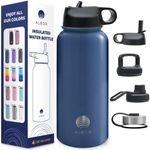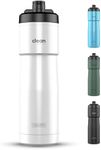Buying Guide for the Best Kids Water Bottles
Choosing the right water bottle for kids is important for keeping them hydrated throughout the day, whether at school, during sports, or on outings. The best bottle should be easy for your child to use, safe, durable, and suited to their daily activities. By understanding the key features, you can select a bottle that matches your child's age, habits, and preferences, making it more likely they'll actually use it.MaterialThe material of a kids' water bottle affects its safety, weight, and durability. Common materials include plastic, stainless steel, and glass. Plastic bottles are lightweight and often come in fun designs, but you should look for BPA-free options for safety. Stainless steel bottles are durable and keep drinks cold or hot longer, but they can be heavier. Glass bottles are safest for taste and health but are more fragile and usually come with a protective sleeve. Consider your child's age and how rough they are with their belongings when choosing the material.
CapacityCapacity refers to how much liquid the bottle can hold, usually measured in ounces or milliliters. Smaller bottles (around 10-12 oz) are easier for younger kids to carry and handle, while older children or those who are very active may need larger bottles (16-20 oz or more) to stay hydrated. Think about how long your child will be away from a refill source and how much they typically drink to pick the right size.
Spout or Lid TypeThe spout or lid type determines how easy and mess-free it is for your child to drink. Options include straw lids, flip-tops, screw-tops, and spouts. Straw lids are great for younger kids as they reduce spills, while flip-tops and spouts are easy for older kids to open and close. Screw-tops are more secure but can be harder for small hands. Choose a lid that matches your child's age and ability to open and close it independently.
Leak-Proof DesignA leak-proof design is crucial for kids' water bottles, especially if the bottle will be carried in a backpack with books and electronics. Some bottles have special seals or locking mechanisms to prevent leaks. If your child tends to toss their bag around or you want to avoid messes, prioritize bottles that are specifically labeled as leak-proof.
Ease of CleaningKids' water bottles need to be cleaned regularly to prevent mold and odors. Bottles with wide mouths are easier to clean by hand, and some are dishwasher-safe for added convenience. Bottles with many small parts or complicated lids can be harder to keep clean. If you want to save time and ensure good hygiene, look for bottles that are easy to disassemble and clean.
InsulationInsulation refers to the bottle's ability to keep drinks cold or hot for longer periods. Double-walled or vacuum-insulated bottles are best for maintaining temperature, which is useful for long days or hot climates. If your child prefers cold water or you live in a warm area, an insulated bottle can be a good choice. For short outings or if temperature isn't a concern, a non-insulated bottle is usually sufficient.
Design and ColorThe design and color of the bottle can make a big difference in whether your child enjoys using it. Bright colors, fun patterns, or favorite characters can encourage kids to drink more water. While this is a personal preference, letting your child pick a design they like can help ensure the bottle doesn't get left behind or forgotten.



















